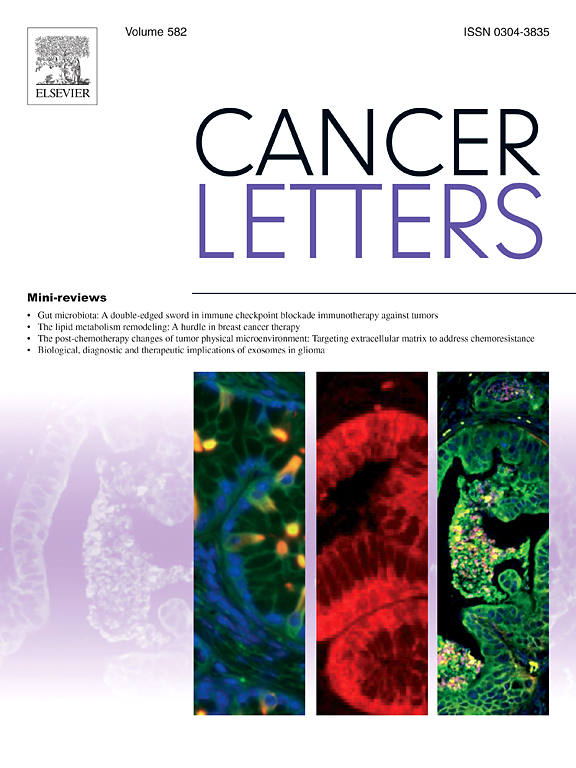Decoding glioblastoma’s diversity: are neurons part of the game?
IF 9.1
1区 医学
Q1 ONCOLOGY
引用次数: 0
Abstract
Glioblastoma multiforme (GBM, WHO Grade 4) is a highly aggressive primary brain tumor with limited treatment options and a poor prognosis. A key challenge in GBM therapy lies in its pronounced heterogeneity, both within individual tumors (intratumoral) and between patients (intertumoral). Historically, neurons have been underexplored in GBM research; however, recent studies reveal that GBM development is closely linked to neural and glial progenitors, often mimicking neurodevelopmental processes in a dysregulated manner. Beyond damaging neuronal tissue, GBM actively engages with neurons to promote pro-tumorigenic signaling, including neuronal hyperexcitability and seizures.
Single-cell RNA sequencing (scRNA-seq) has revolutionized our understanding of the tumor microenvironment (TME), uncovering the critical roles of immune cells, endothelial cells, and astrocytes in tumor progression. However, technical limitations of scRNA-seq hinder its ability to capture the transcriptomes of neurons, necessitating the use of single-nucleus RNA sequencing (snRNA-seq) to study these interactions at single-cell resolution. This work collects the emerging insights of glioblastoma-neuron interactions, focusing on how GBM exploits neurodevelopmental pathways and reshapes neuronal networks. Moreover, we perform bioinformatic analysis of publicly available snRNA-seq datasets to propose putative cell-cell interactions driving glioma-neuronal dynamics. This study delineates key signaling pathways and underscores the need for further investigation to evaluate their potential as therapeutic targets.
解码胶质母细胞瘤的多样性:神经元是游戏的一部分吗?
多形性胶质母细胞瘤(GBM, WHO分级4级)是一种高度侵袭性的原发性脑肿瘤,治疗方案有限,预后差。GBM治疗的一个关键挑战在于其明显的异质性,无论是在单个肿瘤内(肿瘤内)还是在患者之间(肿瘤间)。从历史上看,神经元在GBM研究中的探索不足;然而,最近的研究表明,GBM的发展与神经和胶质祖细胞密切相关,通常以失调的方式模仿神经发育过程。除了破坏神经元组织外,GBM还积极与神经元结合,促进致瘤性信号传导,包括神经元的高兴奋性和癫痫发作。单细胞RNA测序(scRNA-seq)彻底改变了我们对肿瘤微环境(TME)的理解,揭示了免疫细胞、内皮细胞和星形胶质细胞在肿瘤进展中的关键作用。然而,srna -seq的技术限制阻碍了其捕获神经元转录组的能力,因此需要使用单核RNA测序(snRNA-seq)在单细胞分辨率下研究这些相互作用。这项工作收集了胶质母细胞瘤-神经元相互作用的新见解,重点关注胶质母细胞瘤如何利用神经发育途径并重塑神经网络。此外,我们对公开可用的snRNA-seq数据集进行生物信息学分析,以提出驱动胶质瘤-神经元动力学的假定细胞-细胞相互作用。这项研究描述了关键的信号通路,并强调了进一步研究以评估其作为治疗靶点的潜力的必要性。
本文章由计算机程序翻译,如有差异,请以英文原文为准。
求助全文
约1分钟内获得全文
求助全文
来源期刊

Cancer letters
医学-肿瘤学
CiteScore
17.70
自引率
2.10%
发文量
427
审稿时长
15 days
期刊介绍:
Cancer Letters is a reputable international journal that serves as a platform for significant and original contributions in cancer research. The journal welcomes both full-length articles and Mini Reviews in the wide-ranging field of basic and translational oncology. Furthermore, it frequently presents Special Issues that shed light on current and topical areas in cancer research.
Cancer Letters is highly interested in various fundamental aspects that can cater to a diverse readership. These areas include the molecular genetics and cell biology of cancer, radiation biology, molecular pathology, hormones and cancer, viral oncology, metastasis, and chemoprevention. The journal actively focuses on experimental therapeutics, particularly the advancement of targeted therapies for personalized cancer medicine, such as metronomic chemotherapy.
By publishing groundbreaking research and promoting advancements in cancer treatments, Cancer Letters aims to actively contribute to the fight against cancer and the improvement of patient outcomes.
 求助内容:
求助内容: 应助结果提醒方式:
应助结果提醒方式:


